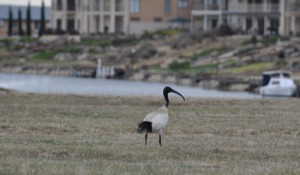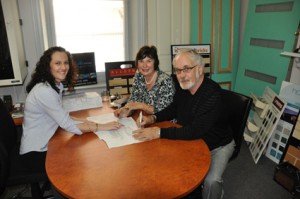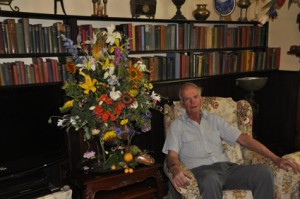Quiet Encounters of a Feathered Kind
 Waterbirds in all their diversity have added a wonderful dimension to our seachange lifestyle.
Waterbirds in all their diversity have added a wonderful dimension to our seachange lifestyle.
Right now we are busily counting nine ducklings paddling alongside mother duck across the waterway towards our jetty.
The babies are being tossed about somewhat in the wake of inclement weather and we breathe a sigh of relief as they all follow mother duck scrambling up the embankment.
Whew!
I ponder on how we all seem to cohabit peacefully as they waddle across the neighbour’s lawn even though The Marina at Hindmarsh Island, where we live temporarily, has encroached mercilessly into their natural habitat. The Marina is lined with big, new McMansions, but these seemingly flimsy feathered creatures of myriad kinds flit and fly around the constructed islands and glide amongst the natural marshes and reeds along the banks.
It is a very special privilege to be able to experience nature so intimately and I have taken to keeping watch and counting how many varieties share our environment.
Am I really a birdwatcher? It is a pastime I never dreamt I would enjoy so much when I retired. Our camera is always at hand to capture exotic images of them.
Such as the unique ibis which have been feeding on the cut grass on hectares of vacant land earmarked for future growth in retirement village housing. They were close to the verge and quite beautiful to watch, dramatic black and white feathered water birds, their long black curved beaks incessantly pecking at the ground.
It is impossible to go shopping without noticing all the birds – countless galahs sitting on the telephone wires, a dozen black cockatoos settled on an old gum near the Hindmarsh Bridge and a few pelicans gliding along the Goolwa channel.
For the first few weeks after we arrived here, each morning we would check if the white heron, who frequented the swampy island across from our jetty was still in attendance. She would stand serenely for hours until one day when she was bothered by a fellow heron, who came flying in to woo her affections. And we do miss her since she flew south with him.
A solitary pelican soon took her watch, gliding past in a majestic manner.
Any number of birds fly overhead and the constant cry of seagulls adds to the roar of the Southern Ocean close by. But nothing causes as much joy as a pelican flying high above us with its awesome wingspan outstretched.
However, our first bird encounter was anything but peaceful. A mating pair of plovers were dangerously aggressive as we took our first stroll down our road. Land on one side of the road is still vacant, subdivided with “for sale’’ signs.
The plovers rose up from the grasses on the land and repeatedly swooped on us and squawked in a menacing manner. And they weren’t having fun, flying far too close to our scalps at full speed to leave us in any doubt of their intent.
Visions of Alfred Hitchcock’s film The Birds sprung to mind as we fended them off and it wasn’t until we succumbed to their demands and hot-tailed for home on the far side of the road that they flew away.
We worked out that plovers nest on the ground and, of course, in September, they had set up house on that large strip of empty land, oblivious that it is the last Spring they will do so.
Their behaviour springs to mind now as I sit on the terrace and watch one plover plunge from a height diving into the water to pluck up some poor fish silly enough to swim too near the surface.
Despite our altercation with plovers, we have become avid birdwatchers and are beginning to photograph waterbirds in their habitat.
Who knows? Santa may bring binoculars.
Our quiet encounters with the birds so brighten our days and we will miss their presence when we eventually move back to town.
 The time of dreaming about our custom-designed retirement home is over.
The time of dreaming about our custom-designed retirement home is over.